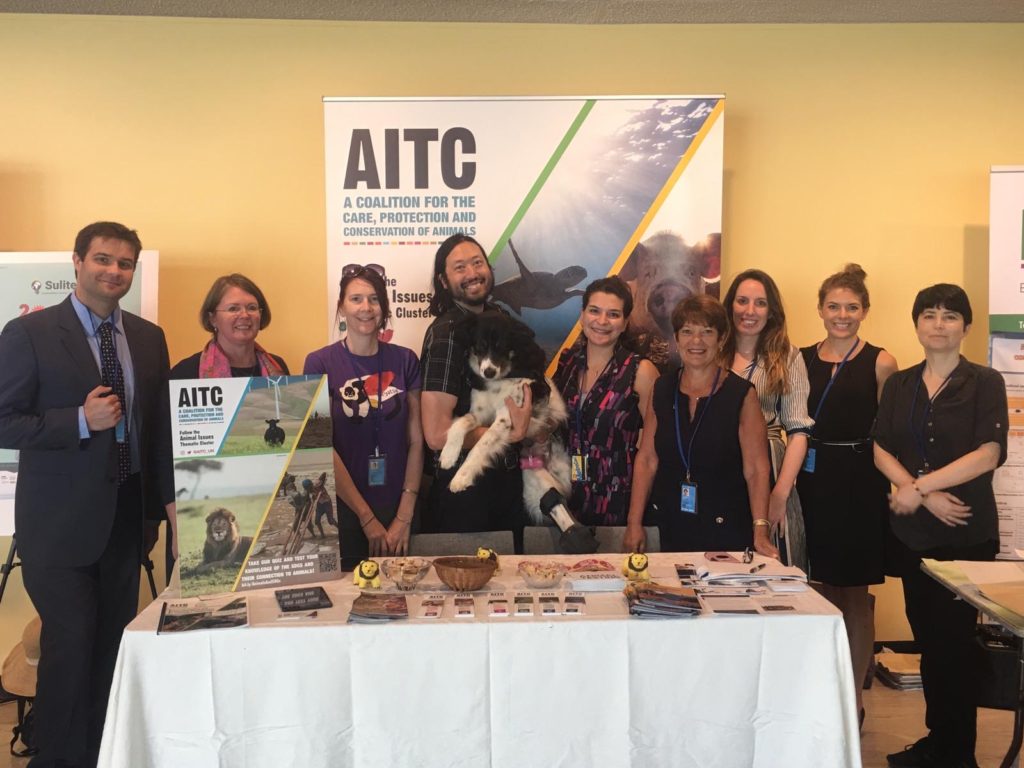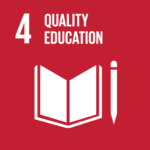From July 7th through July 16th, the United Nations will hold its annual High Level Political Forum (HLPF) partly online this year due to the global COVID-19 pandemic. Animal People has attended the past two HLPFs at the U.N. headquarters in New York City, as a member of the Animal Issues Thematic Cluster (AITC) of the U.N.’s NGO Major Group. In helping to staff the AITC exhibit booth, the most common reaction that we received from delegates was something along the lines of:
“I love animals! Yet it has nothing to do with my work.”
Inevitably, just a few minutes of conversation with the delegate would uncover multiple ways in which their expertise, background, and position did in fact intersect with animal protection concerns. Animal issues have everything to do with sustainable development, across all of its various facets. Recognizing these connections can help animal protection activists to maximize the impact of their work, win favor from governments and policy makers, collaborate with other stakeholders, discover new sources of funds, and appeal more broadly to the general public.
In this article, we will briefly explore various ways in which animal issues relate to the 17 Sustainable Development Goals (SDGs) , developed by the United Nations as part of its 2030 Agenda. More detailed information, and specific case studies, can be found in the book Animal Protection and Sustainable Development: An Indivisible Relationship, which Animal People, in partnership with the rest of the AITC, developed for the 2019 HLPF.
“End poverty in all its forms everywhere.”
Poverty is a major driver of wildlife crime, to the extent that in anonymous surveys, 80% of poachers report poverty and/or food insecurity as their primary motivation. Up to 96% of poachers report that they would give up poaching if alternative livelihoods were available to them.
Poverty also relates to the keeping of working animals. 650 million people worldwide, many below the poverty line, are directly reliant on animals for income. Working animals often play a large role in uplifting families and communities from poverty. In Mali, families with donkeys earn up to three times the average monthly income for their country. The theft and illegal slaughter of donkeys for ejiao – a gelatin derived from boiling down donkey hides, used in traditional Chinese medicine – leaves their keepers without livelihood, endangering human communities in addition to the animals slaughtered for the product.
“End hunger, achieve food security and improved nutrition and promote sustainable agriculture.”
Worldwide, more than 820 million people suffer from chronic hunger. This is aggravated by the inherent inefficiency of animal agriculture. A single pound of grain can feed five times more people if it is eaten directly than if it is used to fatten a chicken, and twenty times more people than if used to fatten a cow. Additionally, more than half of all agricultural plant protein grown worldwide is used as animal feed rather than being fed to humans directly.
Besides crop agriculture, which offers one alternative to the farming and slaughter of livestock, food forests can provide up to seven layers of plant foods from the forest floor to the canopy, while also sequestering carbon and providing wildlife habitat. Food forests provide a potential solution to human hunger as well as a solution to deforestation and habitat destruction impacting wild animals.
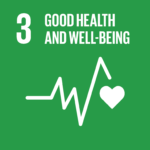 SDG 3 – Good Health and Well-Being
SDG 3 – Good Health and Well-Being
“Ensure healthy lives and promote well-being for all at all ages.”
One Health is a framework recognized by the World Organization for Animal Health (OIE), which highlights the links between human and animal health. 75% of emerging diseases infecting humans are of animal origin, including the novel coronavirus responsible for the COVID-19 pandemic, which has shut down regular operations in countries around the world, as well as Ebola, SARS, and HIV. Emerging zoonotic diseases are becoming an increasing risk to humans due to the wildlife trade, as well as habitat destruction, which increases instances of contact between humans and wildlife.
Factory farms are also breeding grounds for diseases, including mad cow disease and avian and swine flus. The overuse of antibiotics to keep animals alive until reaching slaughter weight selects for antibiotic-resistant strains, while practices such as the feeding of animals on their own species’ meat, extreme crowding, and low sanitation increase risks of infection and disease proliferation.
Good health and well-being also relate to animal issues insofar as medical research remains largely reliant on animal experiments. Despite the prevalence of animal research, up to 96% of drugs tested on animals fail in human trials, showing the need to develop non-animal methods more relevant to human health.
Finally, it has been found that people exposed to nature and to animals are less prone to depression, anxiety, and other mental health issues, highlighting the intersection of animal issues not only with physical human health, but psychological health as well.
“Ensure inclusive and equitable quality education and promote lifelong learning opportunities for all.”
Education intersects most prominently with animal protection within the field of humane education, which aims to teach compassion, respect, and proper care for animals. Studies of humane education curricula show that children taught kindness to animals are more altruistic toward people as well. Humane education has also been found to improve student learning outcomes generally.
On the flip side, children who are exposed to animal cruelty are significantly more likely to commit violent acts impacting humans, highlighting the consequences of failing to model proper treatment of animals, or counteract harmful modeling, early in life.
Regarding adult education, veterinary professionals without proper animal welfare training are less equipped to treat animals, educate animal keepers, or contain zoonotic disease outbreaks.
“Achieve gender equality and empower all women and girls.”
It has been found that there is a strong link between animal abuse and domestic violence, which disproportionately impacts women. Nearly half of U.S. survivors of domestic abuse report staying with their abusers rather than abandoning pets, demonstrating the need to provide for companion animals in order to provide effective relief to human victims of domestic violence.
Many women worldwide are reliant on animals for their livelihood, including two thirds of livestock keepers living in poverty.
On a more abstract level, sexual exploitation of women and the exploitation of non-human animals for food are often linked in popular culture, as shown by Carol Adams in The Sexual Politics of Meat. For example, women and animals are both commonly objectified in terms of their body parts, a practice that in both cases subverts respect or empathy for the sake of physical desire.
Finally, the majority of people working in animal protection are themselves women, so the goal of gender equality is a particularly personal one for those working within the animal protection movement.
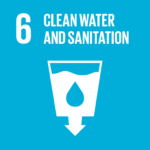 SDG 6 – Clean Water and Sanitation
SDG 6 – Clean Water and Sanitation
“Ensure availability and sustainable management of water and sanitation for all.”
Animal agriculture has an enormous water footprint. Beef, the least efficient animal food product, requires 20 times as much water per calorie to produce as cereals or root vegetables. The waste from livestock, meanwhile, pollutes community reservoirs and can create dead zones in which little if any life is able to survive. In the Gulf of Mexico, dead zones stretch over 14,000 square kilometers on average every summer.
The pollution of waterways, whether by animal agriculture or other causes, is disastrous for ecosystems. Trace amounts of pharmaceuticals and illegal drugs in rivers have been found to be a severe threat to species as diverse as the European eel, salmon in the U.S. Pacific Northwest, and the Australian platypus.
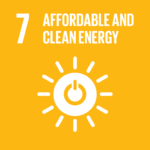 SDG 7 – Affordable and Clean Energy
SDG 7 – Affordable and Clean Energy
“Ensure access to affordable, reliable, sustainable and modern energy for all.”
It is particularly important to recognize the relationship between animal protection and SDG 7, because energy production methods that are relatively sustainable on a global scale can still be harmful to ecosystems locally. For example, some solar power stations actually cause more direct wildlife casualties than do coal plants. This harmful impact can be mitigated by accounting for animals in the design of sustainable energy production methods, as for example in the incorporation of fish ladders and development of fish-friendly turbines in hydroelectric dams.
SDG 7 also relates to the use of working animals such as horses, donkeys, oxen, camels, and others, as the use of working animals can potentially be less energy intensive than using machines powered by fossil fuels. However, the relative efficiency of using working animals depends on high standards of animal welfare and care, to reduce mortality and increase work output. Furthermore, more advanced machinery, powered by alternative energy sources such as biofuels or hydrogen, may be more efficient and less ecologically destructive than either.
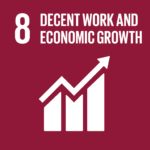 SDG 8 – Decent Work and Economic Growth
SDG 8 – Decent Work and Economic Growth
“Promote sustained, inclusive and sustainable economic growth, full and productive employment and decent work for all.”
Worldwide, 650 million people are directly reliant on domestic animals for livelihoods, and 1.6 billion on forest ecosystems.
Wildlife tourism is a major industry worldwide. Meanwhile, the economic role of consumptive tourism, such as hunting and fishing, is commonly exaggerated. In 2016, $156 billion were spent on wildlife-related activities across the United States, a record high, with more wildlife watching and less hunting than ever before. Wildlife watching accounted for seven times more expenditures than hunting.
Across Africa, wildlife watching tours account for 88% of tourist revenue. Trophy hunting, on the other hand, accounts for no more than 2%. In places where trophy hunting takes place, the practice may in fact deter non-violent tourism, as people who desire to watch or photograph wildlife peacefully may not wish to patronize locations where animals are also killed for sport.
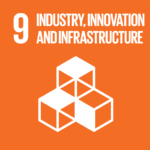 SDG 9 – Industry, Innovation and Infrastructure
SDG 9 – Industry, Innovation and Infrastructure
“Build resilient infrastructure, promote inclusive and sustainable industrialization and foster innovation.”
One promising area of technological innovation is in alternatives to animal use. For example, compared to animal research, tests using human volunteers, cell cultures, chemistry, or computer models often yield more accurate results. There is a particular incentive to develop alternative research methods as more jurisdictions restrict animal testing, as the European Union and Taiwan did for cosmetics testing in 2013 and 2019 respectively.
The alternative protein industry, which develops plant-based and cellular replacements for meat, dairy, and eggs as food sources, has an estimated value of $2.2 billion USD as of 2019, and could grow to as much as $140 billion (10% the current value of the meat industry) within ten years.
In the area of infrastructure development, there is a need to mitigate the impact of new building projects on wildlife and their habitats, for example by routing highways and train lines around wilderness areas instead of through them, and restricting the size of surrounding buffer zones. Also important is the installation of overpasses and underpasses for wildlife to safely cross, reducing roadkill and fragmentation of habitat.
“Reduce inequality within and among countries.”
Economic inequality is a major driver of wildlife crime, and wildlife crime can be successfully combated by addressing the root cause. By providing alternative livelihood training and other community development for the Kalandar tribe, Wildlife SOS ended the practice of bear dancing in India within seven years while also doubling the average salary for Kalandar men and employing some 2,000 Kalandar women.
Exploitative practices in the meat industry disproportionately affect racial minorities and migrants. In the United States, 2.6 times more migrant non-citizens work as meat and poultry workers than in the manufacturing sector.
In some cases, harm of animals is directly linked to histories of oppression against human groups. For example, in the 19th century, the U.S. government encouraged settlers and the military to exterminate bison as a means of starving Native American people into submission. In the present day, Amazonian rainforest fires have in many cases been deliberately set by ranchers – with the tacit support of the Brazilian government – as a method of displacing Indigenous people from land desired for agricultural purposes.
 SDG 11 – Sustainable Cities and Communities
SDG 11 – Sustainable Cities and Communities
“Make cities and human settlements inclusive, safe, resilient and sustainable.”
Cities can be made safer for human residents through spay/neuter and vaccination programs, which control populations of free-roaming dogs and cats (and more rarely other species such as monkeys and rodents), reducing incidents of bites and other direct conflict, and controlling the spread of rabies and other zoonotic diseases transmissible to humans. Spay/neuter and vaccination is more effective than culling, as lethal methods target animals friendly to humans while selecting for the survival of more aggressive or antisocial individuals, and create an immediate void in the habitat, which can be quickly filled by animals from surrounding areas.
On a broader level, as discussed previously, reducing violence toward animals creates safer communities for people as well. Abuse of women and children in the United States is often discovered during animal cruelty investigations, and communities with slaughterhouses suffer higher rates of violent crime than those without.
 SDG 12 – Responsible Consumption and Production
SDG 12 – Responsible Consumption and Production
“Ensure sustainable consumption and production patterns.”
The global population is projected to increase to 9.7 billion people by 2050. Using current food systems, this will require increasing global food production by more than 70%. The world human population could more effectively be fed by shifting food systems away from animal agriculture. To produce one kilogram of grain, it takes 99% less water and releases 78-95% fewer emissions than to produce one kilogram of animal protein. Producing meat from cell cultures, rather than by raising and slaughtering an animal, is estimated to require 99% less land and 96% less water, while producing 96% fewer emissions.
That said, plant agriculture can also have negative impacts when practiced using unsustainable methods. Palm oil deforestation imperils wildlife in southeast Asia, South America, and Africa. That said, the harmful impact of plant agriculture could largely be mitigated through the replacement of livestock farming, as more than half of agricultural plant protein is used as animal feed rather than being fed to humans directly.
SDG 12 also relates to the goal of “Half Earth,” the concept that half of the Earth’s surface must be returned to nature in order to avert the biodiversity crisis, as first explicated by ecologist E.O. Wilson. This may sound like a utopian fantasy, but given that 22% of the Earth’s surface can be considered wild at present, simply freeing up the 30% of ice-free land currently used for livestock production by transitioning to alternative food systems would make Half Earth achievable.
“Take urgent action to combat climate change and its impacts.”
Animal agriculture produces 14.5% of emissions, second only to the transportation sector, according to the UN Food and Agriculture Organization (FAO) in 2013. Climate change is a key driver of species extinction, aggravating the biodiversity crisis. Meanwhile, the migration of species into new territories as their ecosystems change affects the distribution and risk of zoonotic diseases transmissible to humans. Ocean acidification, a result of rising sea temperatures, destroys coral, shellfish, and bivalves, devastating marine ecosystems worldwide and the human communities that depend on them.
In many regions, people and their animals are already impacted by climate-related disasters. In Kenya, severe droughts in 2018 and 2019 killed over half of all livestock in some regions, and placed 3.4 million people in severe food insecurity.
“Conserve and sustainably use the oceans, seas and marine resources for sustainable development.”
Up to 2.7 trillion wild fish are caught every year. According to the FAO, 34% of fisheries worldwide are currently overfished, and 60% are already fished at the maximum sustainable rate.
Aquaculture, the rearing of marine animals for food in captivity, is widely touted as a more ecologically sustainable alternative to fishing, and currently accounts for nearly half of the seafood industry. However, its sustainability is questionable. One quarter of wild caught fish are used as feed for fish on farms, with less than 30% efficiency, so that aquaculture is itself a major driver of overfishing. Aquaculture can pose additional threats as well, such as mangrove deforestation caused by offshore shrimp farms, which exposes coastal human communities to disasters such as storms and tsunamis.
One alternative to the ecological destruction caused by fishing and aquaculture is the development of cell-cultured seafood. Cellular methods of growing fish and shrimp meat have already been invented, and are currently in development for market release in Singapore, Hong Kong, and the United States.
“Protect, restore and promote sustainable use of terrestrial ecosystems, sustainably manage forests, combat desertification, and halt and reverse land degradation and halt biodiversity loss.”
Only 22% of ice-free land can still be considered wild, in the sense that its ecosystems are not dominated by human activity. The biomass of humans and domestic animals currently outweighs all wild land mammals 35 times over.
Worldwide, up to a million species are at risk of extinction. Wild vertebrate populations have declined by 60% worldwide over the past forty years, with most megafaunal species already extinct everywhere except Africa and South Asia. Over 40% of insect species, which by many measures are even more essential to overall ecological health, are at risk of extinction.
Achieving SDG 15 requires not only acknowledging that wild animals need more habitat, but recognizing that they also need connected habitat to survive. Habitat fragmentation can be counteracted through the construction of wildlife overpasses and underpasses across roads and railways, as well as corridors for migration between already protected areas, as the American Prairie Reserve in Montana is working to establish.
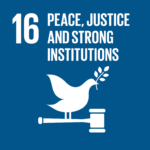 SDG 16 – Peace, Justice and Strong Institutions
SDG 16 – Peace, Justice and Strong Institutions
“Promote peaceful and inclusive societies for sustainable development, provide access to justice for all and build effective, accountable and inclusive institutions at all levels.”
Wildlife crime is the fourth largest illegal global trade, worth up to $23 billion USD. Wildlife crime is enabled by corruption and weak governance, and poses an immediate threat to human life as well. Worldwide, up to a thousand rangers have been murdered by poachers in the last decade. Meanwhile, zoonotic disease outbreaks such as the COVID-19 pandemic are facilitated by the trade in captured wildlife (illegal and legal), claiming thousands or even millions more human lives.
As discussed previously, violence toward animals and violence toward people are strongly interlinked. Domestic violence correlates strongly with animal abuse within the same household. Communities with slaughterhouses suffer higher rates of violent crime than those without. On a psychological level, the dehumanization of people by likening them to animals is a tactic often used deliberately to justify warfare, police brutality, and other forms of violence and oppression against people.
![]() SDG 17 – Partnerships for the Goals
SDG 17 – Partnerships for the Goals
“Strengthen the means of implementation and revitalize the global partnership for sustainable development.”
Animal welfare and conservation are increasingly recognized as priorities in international policy, for example in the OIE’s animal welfare standards, the African Union’s animal welfare strategy, and in SDGs 14 and 15 of the U.N.’s 2030 Agenda. However, in practice governments vary widely in legislation, policy, and enforcement, leaving much of the burden to local and international NGOs.
NGOs possess a wealth of expertise, personnel, and other resources necessary to facilitate sustainable development and animal protection. There is also a place for private industry, as in the fields of ecotourism, alternative protein development, low emissions technology, and other advances beneficial to humans and non-human animals alike.
Forums like the Africa Animal Welfare Conference and Asia for Animals conference series, both co-sponsored by Animal People, foster needed partnerships between all of the above mentioned parties.
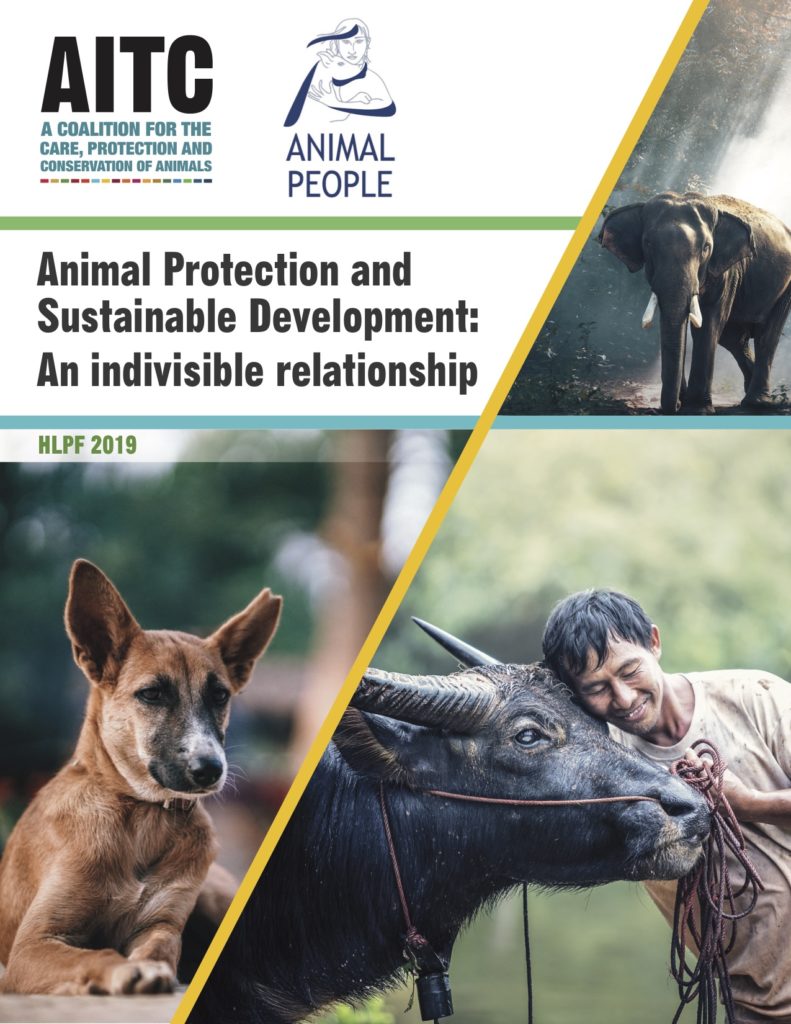 These are just a few of the many important ways in which animal protection issues relate to each and every one of the Sustainable Development Goals. For more detailed information, you may download for free the book Animal Protection and Sustainable Development: An Indivisible Relationship, which includes case studies focusing specifically on the six SDGs examined during the 2019 High Level Political Forum.
These are just a few of the many important ways in which animal protection issues relate to each and every one of the Sustainable Development Goals. For more detailed information, you may download for free the book Animal Protection and Sustainable Development: An Indivisible Relationship, which includes case studies focusing specifically on the six SDGs examined during the 2019 High Level Political Forum.
Please also visit the website of the Animal Issues Thematic Cluster for information on this year’s High Level Political Forum and the AITC’s involvement.
Featured image: boys with a working donkey in Egypt. Image credit Kim Bartlett – Animal People, Inc.


